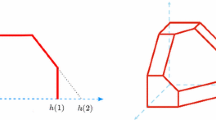Abstract
The computer simulation of realistic networks is an important tool for the development of new protocols or algorithms for communication networks as well as for the optimization of existing technologies. The traditional approach for network simulations is to connect a certain amount of sources to a some network nodes and to measure the traffic intensities, end-to-end delay and further performance parameters.
Network providers have a different view of the problem: The traffic intensities in their network is known, and their target is to optimize the current network. So the first step is to configure the simulation model to generate approximately the same traffic that was measured in the real network.
We discuss the problem of generating a traffic with known characteristics in this paper. We propose a method for dimensioning the number of HTTP/TCP source models for each flow so that the difference between traffic matrix values observed in the real network and in the simulation model is minimized. We show an improved version of our model presented already in [1,2,3] that performs better for the case of large HTTP downloads and small off-times (where the average off time is not much larger than the average download time).
The new aspect in this paper is the discussion of the important aspect for modeling the burstiness of the traffic. We show with a simulation study in this paper that the Hurst parameter, one measure for the burstiness, can be adjusted by the shape parameter a of the truncated power-tail distribution of the HTTP object sizes. We discuss one interesting effect of high Hurst parameter values for link load values bigger than 90 %.
Access this chapter
Tax calculation will be finalised at checkout
Purchases are for personal use only
Preview
Unable to display preview. Download preview PDF.
Similar content being viewed by others
References
K. Below and U. Killat, “On the configuration of simulations of large network models with HTTP/TCP sources,” in 15th ITC Specialist Seminar, Internet Traffic Engineering and Traffic Management, P. Tran-Gia and J. Roberts, Eds., Würzburg, July 2002, pp. 143–149.
K. Below and U. Killat, “Allocation of HTTP/TCP sources for traffic generation in large network simulations,” in 2nd Polish-German Teletraffic Symposium (PGTS 2002), Gdansk, Poland, Sept. 2002, pp. 175–182.
K. Below and U. Killat, “Internet traffic generation for large simulations scenarios with a target traffic matrix,” in 2nd WSEAS International Conference on Simulation, Modelling and Optimization (WSEAS ICOSMO 2002), Skiathos, Greece, Sept. 2002, pp. 2901–2906.
Robert Morris, “Scalable TCP congestion control,” in IEEE INFOCOM 2000, Tel Aviv, Mar. 2000, pp. 1176–1183.
Sally Floyd and Vern Paxson, “Difficulties in simulating the internet,” IEEE/ACM Transactions on Networking, vol. 9, no. 4, pp. 392–403, Aug. 2001.
Will E. Leland, Murad S. Taqqu, Walter Willinger, and Daniel V. Wilson, “On the self-similar nature of ethernet traffic,” Tech. Rep., Bellcore, Boston University, Mar. 1993.
Mark E. Crovella and Azer Bestavros, “Self-similarity in World Wide Web traffic: Evidence and possible causes,” IEEE/ACM Transactions on networking, vol. 5, no. 6, pp. 835–846, Dec. 1997.
Vern Paxson and Sally Floyd, “Wide-area traffic: The failure of poisson modeling,” IEEE/ACM Transactions on Networking, vol. 3, no. 3, pp. 226–244, June 1995.
Hyoung-Kee Choi and John O. Limb, “A behavioral model of web traffic,” in Proceedings of the Seventh Annual International Conference on Network Protocols, Toronto, Canada, Nov. 1999.
University of California at Berkeley, “Ptolemy classic,” http://ptolemy.eecs.berkeley.edu/ptolemyclassic/body.htm
UCB/USC/LBNL/VINT, “Network simulator ns (version 2),” Avaliable from http://www.isi.edu/nsnam/ns/.
Mark E. Crovella and Azer Bestavros, “Explaining World Wide Web traffic self-similarity,” Tech. Rep., Boston University, Oct. 1995.
Kihong Park, Gitae Kim, and Mark Crovella, “On the relationship between file sizes, transport protocols, and self-similar network traffic,” Tech. Rep., Boston University, July 1996.
Michael Greiner, Manfred Jobmann, and Lester Lipsky, “The importance of power-tail distributions for modeling queueing systems,” Operations Research, vol. 47, no. 2, 1999.
K. Below, C. Schwill, and U. Killat, “Erhöhung des Nutzungsgrades eines ATM Netzes für den Wissenschaftsbereich (ERNANI),” Tech. Rep., Dept. Communication Networks, Technical University Hamburg-Harburg, Sept. 2001, http://www.tu-harburg.de/et6/papers/documents/Below_Kai/Abschlussbericht-ERNANI.pdf/et6/papers/documents/Below_Kai/Abschlussbericht-ERNANI.pdf.
P. Abry and D. Veitch, “Wavelet analysis of long-range-dependent traffic,” IEEE Transactions on Information Theory, vol. 44, no. 1, pp. 2–15, 1998.
17. Darryl Veitch and Patrice Abry, “A wavelet based joint estimator of the parameters of long-range dependence,” IEEE Transactions on Information Theory, vol. 45, no. 3, pp. 878–897, 1999.
Author information
Authors and Affiliations
Editor information
Editors and Affiliations
Rights and permissions
Copyright information
© 2003 Springer-Verlag Berlin Heidelberg
About this paper
Cite this paper
Below, K., Killat, U. (2003). Generating Prescribed Traffic with HTTP/TCP Sources for Large Simulation Models. In: Irmscher, K., Fähnrich, KP. (eds) Kommunikation in Verteilten Systemen (KiVS). Informatik aktuell. Springer, Berlin, Heidelberg. https://doi.org/10.1007/978-3-642-55569-5_23
Download citation
DOI: https://doi.org/10.1007/978-3-642-55569-5_23
Publisher Name: Springer, Berlin, Heidelberg
Print ISBN: 978-3-540-00365-6
Online ISBN: 978-3-642-55569-5
eBook Packages: Springer Book Archive




